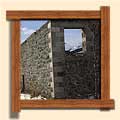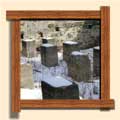 Heritage Community Foundation Presents
Heritage Community Foundation PresentsAlberta Online Encyclopedia
 |
|||||||||||||||||||||||||||
  |
|||||||||||||||||||||||||||
|
Home>> The Industry>> Mines>> Crowsnest Pass>> Leitch Collieries |
|||||||||||||||||||||||||||
| Leitch Collieries | |||||||||||||||||||||||||||
Page 1 | 2 | 3 | 4 | 5 | 6 | 7 | 8 | 9
By this time the limestone cliff which had provided so much building stone, was a yawning cavern in the side of the hill. All this beehive of activity had required the services of many men, the building of another store by the Kerr Brothers, a bank, a hotel, a doctor and many more homes on the townsite. Pioneer problems persisted. The road behind the Hamilton house, leading to town, to school or church was so steep that the new gravity fed cars coming on the market had to go up the hill backwards. And at night the wife would take the rear coal-oil lamp off the back fender and lead the way so as to keep the driver from going over the steep embankment. Considering the large amount of work involved coal production got underway creditably fast. The company had limited operating capital and from the start endeavoured to keep spending within reasonable reach of coal returns. Assay reports showed they had the highest quality of steam and coking coal, with samples showing higher fixed carbon, less ash, and less sulphur than Connellsville in the States, considered to be the best on the market, and the B.T.U/s were comparable. A sample assay follows:
Milton Hersey Co. Ltd., the well known assay chemists, made the signed comment:
The C.P.R. said they would take all the coal they could
produce, and there were other customers who promised to buy on a
regular basis if they could have consideration. Production had
reached one hundred and twenty-five to one hundred and
seventy-five tons daily, and they were showing a small monthly
profit. As against today's mining figures one should remember
the time, and that they were receiving an average of probably
one dollar and a half per ton, as against today's latest figures
of $56.07 per tonne (1977). For the month of March 1909 the
profit was five thousand dollars. This article is extracted from Crowsnest and its People: Millennium Edition (Coleman, Alberta, Crowsnest Pass Historical Society, 2000.) The Heritage Community Foundation and the Year of the Coal Miner Consortium would like to thank the authors and the Crowsnest Pass Historical Society for permission to reprint this material. |
|||||||||||||||||||||||||||
 |
|||||||||||||||||||||||||||
For more on coal mining in Western Canada, visit Peel’s Prairie Provinces.



